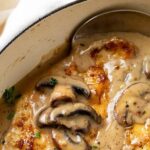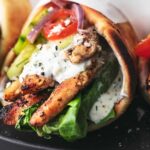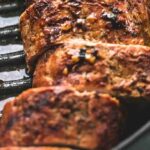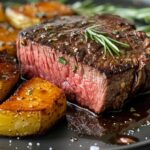Baked Honey Cilantro Lime Salmon in Foil
Are you ready to bake up the best baked salmon of your entire life? Let’s get to it!
First, preheat the oven to 350 degrees. Next, line and grease a large baking sheet with foil. If you don’t have foil, or don’t want to use it, no worries, just grease a large baking sheet and proceed to the next steps.
Lay the salmon on the foil/baking sheet and season with salt and pepper on both sides. Place lime slices under the salmon (so you get that lime taste from under and above the salmon!).
Next, stir the butter, lime juice, honey, and garlic together. Pour this mixture over the salmon and fold up the sides of the foil over the salmon. If the sides don’t touch, it’s okay.
Place in the oven for 15-20 minutes, then change the oven over to “broil” and cook the salmon another 5 minutes under the broiler.
Serve sprinkled with chopped cilantro, if desired.
Do You Bake Salmon Covered or Uncovered?
Whether or not you bake salmon covered or uncovered depends on the recipe. I bake it uncovered so that it develops a nice, crisp top from baking then broiling. If you close it up in foil, it will steam rather than bake.
Do You Have to Wash Salmon Before Cooking?
You don’t have to wash your salmon, but I do give mine a little rinse under cold water and then pat dry with a paper towel before putting it on the baking sheet. This helps to “freshen” up older (not expired, but not just-caught-from-the-ocean, either) fish and makes your seasonings stick to the honey salmon better for cooking.
Expert Tips
If you don’t have a huge salmon fillet, don’t worry about it. This baked salmon recipe works for a large salmon or a couple of medium-sized fillets, or even several small fillets. Just watch the cooking of smaller pieces so that they don’t overcook.
Salmon already has a high fat content and can cook in its own fat just fine if you don’t want to add all the butter. Cut the butter back to just 4 tablespoons and it’ll still taste amazing — if not quite as buttery.
Be sure to bake the salmon skin-side down (if yours has skin) and leave the skin on. The skin creates a barrier between the cooking element and the flesh. So, if anything happens to stick to the baked salmon in foil, it’ll be the skin, and it’ll also be so easy to take right off once baked.
If you aren’t cooking one big fillet, try to cook up smaller pieces or fillets that are about the same size, that way you won’t overcook some and undercook others.
To help the seasonings stick to the salmon, pat the salmon dry before adding salt and pepper. That will make the skin get crispy too, and help keep the salmon moist.






Leave a Reply